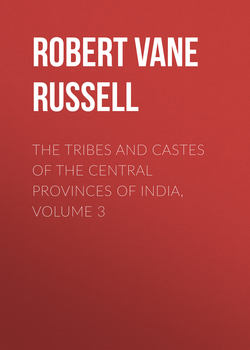Читать книгу The Tribes and Castes of the Central Provinces of India, Volume 3 - Robert Vane Russell - Страница 3
Gadaria
2. Subdivisions
ОглавлениеThe Gadarias are a very mixed caste. They themselves say that their first ancestor was created by Mahādeo to tend his rams, and that he married three women who were fascinated by the sight of him shearing the sheep. These belonged to the Brāhman, Dhīmar and Barai castes respectively, and became the ancestors of the Nikhar, Dhengar and Barmaiyan subcastes of Gadarias. The Nikhar subcaste are the highest, their name meaning pure. Dhengar is probably, in reality, a corruption of Dhangar, the name of the Marātha shepherd caste. They have other subdivisions of the common territorial type, as Jheria or jungly, applied to the Gadarias of Chhattīsgarh; Desha from desh, country, meaning those who came from northern India; Purvaiya or eastern, applied to immigrants from Oudh; and Mālvi or those belonging to Mālwa. Nikhar and Dhengar men take food together, but not the women; and if a marriage cannot be otherwise arranged these subcastes will sometimes give daughters to each other. A girl thus married is no longer permitted to take food at her father’s house, but she may eat with the women of her husband’s subcaste. Many of their exogamous groups are named after animals or plants, as Hiranwār, from hiran, a deer; Sapha from the cobra, Moria from the peacock, Nāhar from the tiger, Phulsungha, a flower, and so on. Others are the names of Rājpūt septs and of other castes, as Ahirwār (Ahīr) and Bamhania (Brāhman).
Another more ambitious legend derives their origin from the Bania caste. They say that once a Bania was walking along the road with a cocoanut in his hand when Vishnu met him and asked him what it was. The Bania answered that it was a cocoanut. Vishnu said that it was not a cocoanut but wool, and told him to break it, and on breaking the cocoanut the Bania found that it was filled with wool. The Bania asked what he should do with it, and Vishnu told him to make a blanket out of it for the god to sit on. So he made a blanket, and Vishnu said that from that day he should be the ancestor of the Gadaria caste, and earn his bread by making blankets from the wool of sheep. The Bania asked where he should get the sheep from, and the god told him to go home saying ‘Ehān, Ehān, Ehān,’ all the way, and when he got home he would find a flock of sheep following him; but he was not to look behind him all the way. And the Bania did so, but when he had almost got home he could not help looking behind him to see if there were really any sheep. And he saw a long line of sheep following him in single file, and at the very end was a ram with golden horns just rising out of the ground. But as he looked it sank back again into the ground, and he went back to Vishnu and begged for it, but Vishnu said that as he had looked behind him he had lost it. And this was the origin of the Gadaria caste, and the Gadarias always say ‘Ehān, Ehān,’ as they lead their flocks of sheep and goats to pasture.
